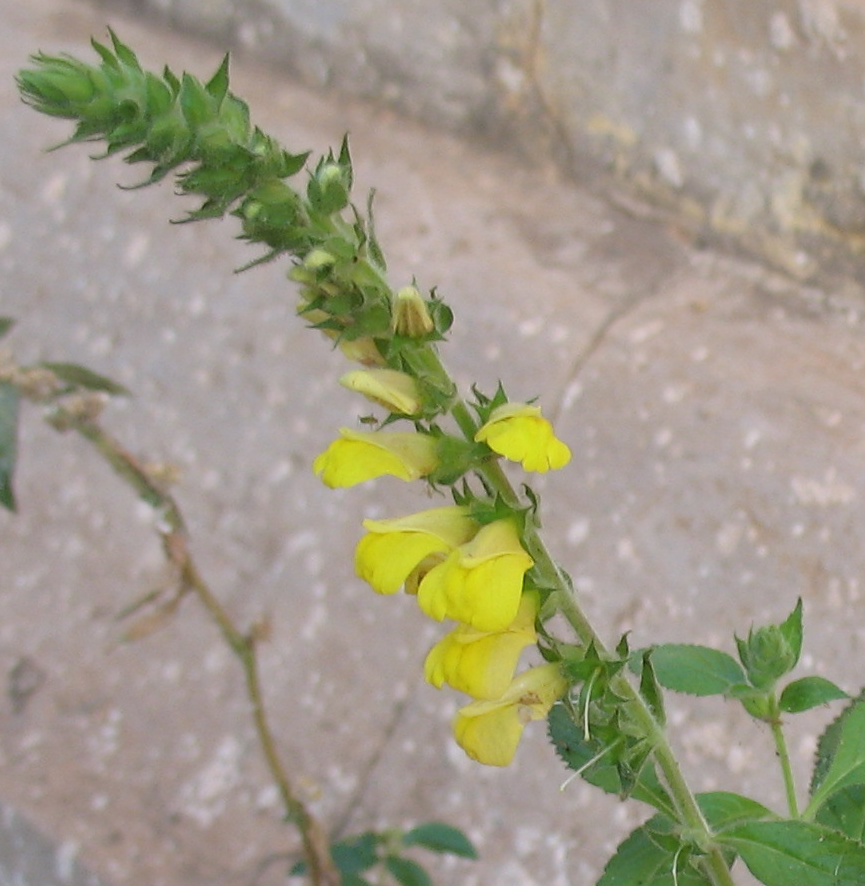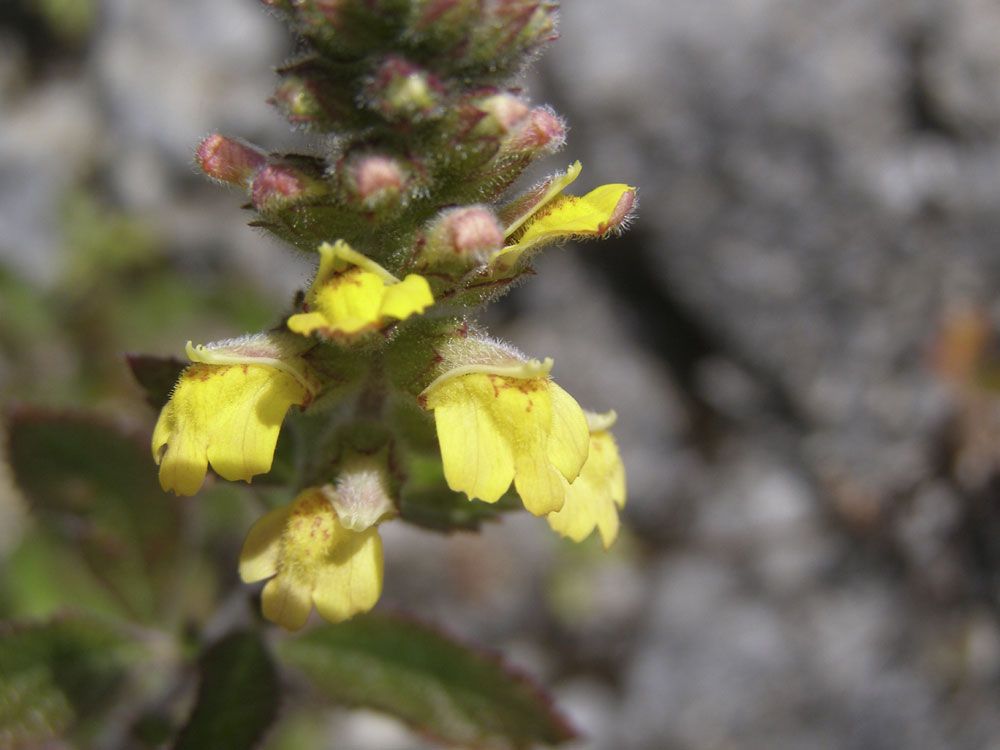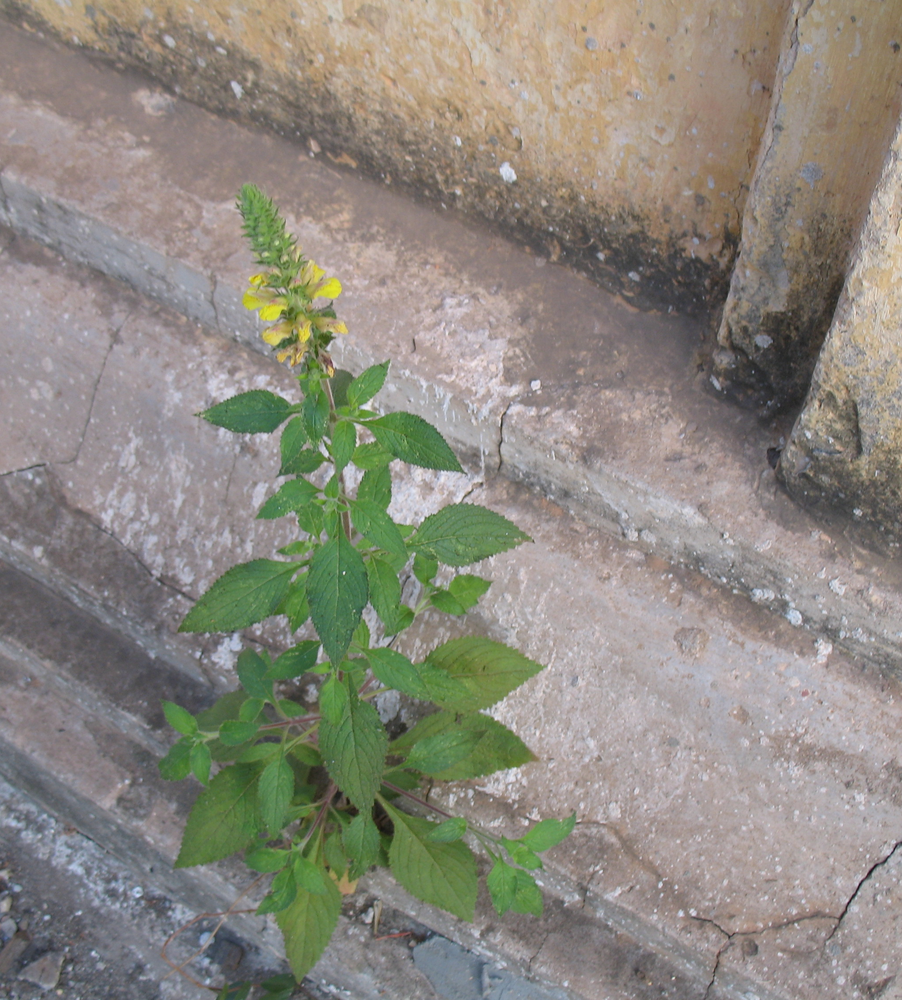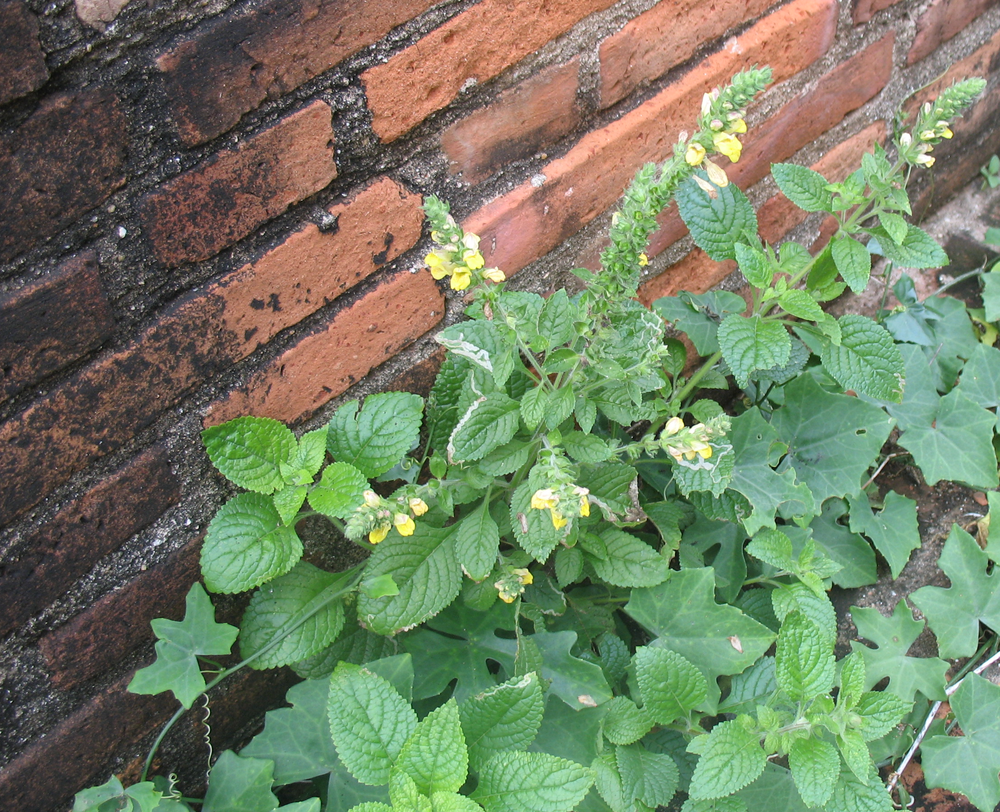No French or English name for this modest Asian plant which poses some problems for the botanist. Indeed its classification is uncertain. It is classified in the Scrofulariaceae family, and yet it is not a parasitic plant (new classification: Plantaginaceae); it is called “philippensis” and yet it is not native to the Philippines but to India and China. The genus Lindenbergia includes a dozen species in tropical and subtropical Africa and especially in Asia, particularly in India. This scientific name was given to it to honor a German scientist, bryologist (who studies mosses), Johann Bernhard Wilhelm Lindenberg,
Lindenbergia philippensis is found in the Indochinese peninsula up to a height of 800 meters. It is a perennial herb, with simple, oval, toothed leaves, covered with hairy glands. The flowers, also hairy, are grouped in a terminal spike; their corolla is yellow, irregular, composed of 5 petals forming lips; the upper one has 2 shorter petals than the lower one which has 3 facing downwards. The fruit is an ovoid capsule containing very small oblong seeds.
Each time we saw this plant, it was, in Laos as in Thailand, within the walls of a pagoda, in the corner of an old temple or along a brick wall. This is in fact its preferred habitat, it is an anthropophilic plant, in other words which likes the company of men; it is also sometimes found along roadsides or in the rocky beds of certain rivers.
The Lao name is not very clear because it evokes a very bad smell: phak mèn, “vegetable that smells bad” or sap hèng “smell of carrion”; It is true that crumpled leaves have an unpleasant but acceptable odor. As for the “vegetable” we haven’t found anyone to tell us that we can eat this plant. On the other hand, it is reported as a medicinal plant. It is its leaves which are used externally; the whole plant is crushed and moistened with alcohol and this lotion is applied in case of headache or flu. On wounds, burns, abscesses, spread a little juice from simply crushed leaves.
Different scientific studies are carried out, particularly in Thailand, on this plant; it was thus discovered that it could reduce cholesterol levels…in rats. It would also have the ability to absorb certain metals which contaminate the ground such as zinc, this is perhaps one of the possible explanations for its preference for old walls.
Pas de nom français ou anglais pour cette modeste plante asiatique qui pose quelques problèmes au botaniste. En effet son classement est incertain. Elle est rangée dans la famille des Scrofulariacées, et pourtant elle n’est pas une plante parasite (nouveau classement: Plantaginaceae); on la nomme « philippensis » et pourtant elle n’est pas originaire des Philippines mais de l’Inde et de la Chine. Le genre Lindenbergia comprend une douzaine d’espèces en Afrique tropicale et subtropicale et surtout en Asie, en particulier en Inde. Ce nom scientifique lui a été donné pour honorer un savant allemand, bryologiste (qui étudie les mousses), Johann Bernhard Wilhelm Lindenberg,
Lindenbergia philippensis se rencontre dans la péninsule indochinoise jusqu’à une hauteur de 800 mètres. C’est une herbe pérenne, aux feuilles simples, ovales, dentées, couvertes de glandes poilues. Les fleurs, également poilues, sont groupées en épi terminal; leur corolle est jaune, irrégulière, composée de 5 pétales formant des lèvres; la supérieure a 2 pétales plus courts que l’inférieure qui en a 3 tournés vers le bas. Le fruit est une capsule ovoïde contenant de toutes petites graines oblongues.
A chaque fois que nous avons vu cette plante, c’était, au Laos comme en Thaïlande, dans l’enceinte d’une pagode, au coin d’un vieux temple ou le long d’un mur de brique. C’est là en effet son habitat préféré, c’est une plante anthropophile, autrement dit qui aime la compagnie des hommes; on la trouve également parfois au bord des chemins ou dans le lit rocheux de certaines rivières.
Le nom lao n’est pas très clair car il évoque une très mauvaise odeur: phak mèn, « légume qui sent mauvais » ou sap hèng « odeur de charognard »; il est vrai que les feuilles froissées ont une odeur peu agréable mais acceptable cependant. Quant au « légume » nous n’avons trouvé personne pour nous dire que l’on pouvait manger cette plante. En revanche elle est signalée comme plante médicinale. Ce sont ses feuilles qui sont employées en usage externe; la plante toute entière est écrasées et mouillée d’alcool et cette lotion est appliquée en cas de mal de tête ou de grippe. Sur les plaies, brûlures, abcès, on étale un peu du jus des feuilles simplement broyées.
Différentes études scientifiques sont menées, en particulier en Thaïlande, sur cette plante; on a ainsi découvert qu’elle pouvait réduire le taux de cholestérol…chez les rats. Elle aurait aussi la faculté d’absorber certains métaux qui contaminent le sol comme le zinc, c’est peut-être l’une des explications possibles de sa préférence pour les vieux murs.




No French or English name for this modest Asian plant which poses some problems for the botanist. Indeed its classification is uncertain. It is classified in the Scrofulariaceae family, and yet it is not a parasitic plant (new classification: Plantaginaceae); it is called “philippensis” and yet it is not native to the Philippines but to India and China. The genus Lindenbergia includes a dozen species in tropical and subtropical Africa and especially in Asia, particularly in India. This scientific name was given to it to honor a German scientist, bryologist (who studies mosses), Johann Bernhard Wilhelm Lindenberg,
Lindenbergia philippensis is found in the Indochinese peninsula up to a height of 800 meters. It is a perennial herb, with simple, oval, toothed leaves, covered with hairy glands. The flowers, also hairy, are grouped in a terminal spike; their corolla is yellow, irregular, composed of 5 petals forming lips; the upper one has 2 shorter petals than the lower one which has 3 facing downwards. The fruit is an ovoid capsule containing very small oblong seeds.
Each time we saw this plant, it was, in Laos as in Thailand, within the walls of a pagoda, in the corner of an old temple or along a brick wall. This is in fact its preferred habitat, it is an anthropophilic plant, in other words which likes the company of men; it is also sometimes found along roadsides or in the rocky beds of certain rivers.
The Lao name is not very clear because it evokes a very bad smell: phak mèn, “vegetable that smells bad” or sap hèng “smell of carrion”; It is true that crumpled leaves have an unpleasant but acceptable odor. As for the “vegetable” we haven’t found anyone to tell us that we can eat this plant. On the other hand, it is reported as a medicinal plant. It is its leaves which are used externally; the whole plant is crushed and moistened with alcohol and this lotion is applied in case of headache or flu. On wounds, burns, abscesses, spread a little juice from simply crushed leaves.
Different scientific studies are carried out, particularly in Thailand, on this plant; it was thus discovered that it could reduce cholesterol levels…in rats. It would also have the ability to absorb certain metals which contaminate the ground such as zinc, this is perhaps one of the possible explanations for its preference for old walls.
Pas de nom français ou anglais pour cette modeste plante asiatique qui pose quelques problèmes au botaniste. En effet son classement est incertain. Elle est rangée dans la famille des Scrofulariacées, et pourtant elle n’est pas une plante parasite (nouveau classement: Plantaginaceae); on la nomme « philippensis » et pourtant elle n’est pas originaire des Philippines mais de l’Inde et de la Chine. Le genre Lindenbergia comprend une douzaine d’espèces en Afrique tropicale et subtropicale et surtout en Asie, en particulier en Inde. Ce nom scientifique lui a été donné pour honorer un savant allemand, bryologiste (qui étudie les mousses), Johann Bernhard Wilhelm Lindenberg,
Lindenbergia philippensis se rencontre dans la péninsule indochinoise jusqu’à une hauteur de 800 mètres. C’est une herbe pérenne, aux feuilles simples, ovales, dentées, couvertes de glandes poilues. Les fleurs, également poilues, sont groupées en épi terminal; leur corolle est jaune, irrégulière, composée de 5 pétales formant des lèvres; la supérieure a 2 pétales plus courts que l’inférieure qui en a 3 tournés vers le bas. Le fruit est une capsule ovoïde contenant de toutes petites graines oblongues.
A chaque fois que nous avons vu cette plante, c’était, au Laos comme en Thaïlande, dans l’enceinte d’une pagode, au coin d’un vieux temple ou le long d’un mur de brique. C’est là en effet son habitat préféré, c’est une plante anthropophile, autrement dit qui aime la compagnie des hommes; on la trouve également parfois au bord des chemins ou dans le lit rocheux de certaines rivières.
Le nom lao n’est pas très clair car il évoque une très mauvaise odeur: phak mèn, « légume qui sent mauvais » ou sap hèng « odeur de charognard »; il est vrai que les feuilles froissées ont une odeur peu agréable mais acceptable cependant. Quant au « légume » nous n’avons trouvé personne pour nous dire que l’on pouvait manger cette plante. En revanche elle est signalée comme plante médicinale. Ce sont ses feuilles qui sont employées en usage externe; la plante toute entière est écrasées et mouillée d’alcool et cette lotion est appliquée en cas de mal de tête ou de grippe. Sur les plaies, brûlures, abcès, on étale un peu du jus des feuilles simplement broyées.
Différentes études scientifiques sont menées, en particulier en Thaïlande, sur cette plante; on a ainsi découvert qu’elle pouvait réduire le taux de cholestérol…chez les rats. Elle aurait aussi la faculté d’absorber certains métaux qui contaminent le sol comme le zinc, c’est peut-être l’une des explications possibles de sa préférence pour les vieux murs.








No French or English name for this modest Asian plant which poses some problems for the botanist. Indeed its classification is uncertain. It is classified in the Scrofulariaceae family, and yet it is not a parasitic plant (new classification: Plantaginaceae); it is called “philippensis” and yet it is not native to the Philippines but to India and China. The genus Lindenbergia includes a dozen species in tropical and subtropical Africa and especially in Asia, particularly in India. This scientific name was given to it to honor a German scientist, bryologist (who studies mosses), Johann Bernhard Wilhelm Lindenberg,
Lindenbergia philippensis is found in the Indochinese peninsula up to a height of 800 meters. It is a perennial herb, with simple, oval, toothed leaves, covered with hairy glands. The flowers, also hairy, are grouped in a terminal spike; their corolla is yellow, irregular, composed of 5 petals forming lips; the upper one has 2 shorter petals than the lower one which has 3 facing downwards. The fruit is an ovoid capsule containing very small oblong seeds.
Each time we saw this plant, it was, in Laos as in Thailand, within the walls of a pagoda, in the corner of an old temple or along a brick wall. This is in fact its preferred habitat, it is an anthropophilic plant, in other words which likes the company of men; it is also sometimes found along roadsides or in the rocky beds of certain rivers.
The Lao name is not very clear because it evokes a very bad smell: phak mèn, “vegetable that smells bad” or sap hèng “smell of carrion”; It is true that crumpled leaves have an unpleasant but acceptable odor. As for the “vegetable” we haven’t found anyone to tell us that we can eat this plant. On the other hand, it is reported as a medicinal plant. It is its leaves which are used externally; the whole plant is crushed and moistened with alcohol and this lotion is applied in case of headache or flu. On wounds, burns, abscesses, spread a little juice from simply crushed leaves.
Different scientific studies are carried out, particularly in Thailand, on this plant; it was thus discovered that it could reduce cholesterol levels…in rats. It would also have the ability to absorb certain metals which contaminate the ground such as zinc, this is perhaps one of the possible explanations for its preference for old walls.
Pas de nom français ou anglais pour cette modeste plante asiatique qui pose quelques problèmes au botaniste. En effet son classement est incertain. Elle est rangée dans la famille des Scrofulariacées, et pourtant elle n’est pas une plante parasite (nouveau classement: Plantaginaceae); on la nomme « philippensis » et pourtant elle n’est pas originaire des Philippines mais de l’Inde et de la Chine. Le genre Lindenbergia comprend une douzaine d’espèces en Afrique tropicale et subtropicale et surtout en Asie, en particulier en Inde. Ce nom scientifique lui a été donné pour honorer un savant allemand, bryologiste (qui étudie les mousses), Johann Bernhard Wilhelm Lindenberg,
Lindenbergia philippensis se rencontre dans la péninsule indochinoise jusqu’à une hauteur de 800 mètres. C’est une herbe pérenne, aux feuilles simples, ovales, dentées, couvertes de glandes poilues. Les fleurs, également poilues, sont groupées en épi terminal; leur corolle est jaune, irrégulière, composée de 5 pétales formant des lèvres; la supérieure a 2 pétales plus courts que l’inférieure qui en a 3 tournés vers le bas. Le fruit est une capsule ovoïde contenant de toutes petites graines oblongues.
A chaque fois que nous avons vu cette plante, c’était, au Laos comme en Thaïlande, dans l’enceinte d’une pagode, au coin d’un vieux temple ou le long d’un mur de brique. C’est là en effet son habitat préféré, c’est une plante anthropophile, autrement dit qui aime la compagnie des hommes; on la trouve également parfois au bord des chemins ou dans le lit rocheux de certaines rivières.
Le nom lao n’est pas très clair car il évoque une très mauvaise odeur: phak mèn, « légume qui sent mauvais » ou sap hèng « odeur de charognard »; il est vrai que les feuilles froissées ont une odeur peu agréable mais acceptable cependant. Quant au « légume » nous n’avons trouvé personne pour nous dire que l’on pouvait manger cette plante. En revanche elle est signalée comme plante médicinale. Ce sont ses feuilles qui sont employées en usage externe; la plante toute entière est écrasées et mouillée d’alcool et cette lotion est appliquée en cas de mal de tête ou de grippe. Sur les plaies, brûlures, abcès, on étale un peu du jus des feuilles simplement broyées.
Différentes études scientifiques sont menées, en particulier en Thaïlande, sur cette plante; on a ainsi découvert qu’elle pouvait réduire le taux de cholestérol…chez les rats. Elle aurait aussi la faculté d’absorber certains métaux qui contaminent le sol comme le zinc, c’est peut-être l’une des explications possibles de sa préférence pour les vieux murs.


